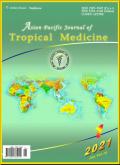COVID-19 vaccine uptake and its determinants among teenagers and their parents in Zhejiang, China: An online cross-sectional study
IF 1.6
4区 医学
Q3 PUBLIC, ENVIRONMENTAL & OCCUPATIONAL HEALTH
引用次数: 0
Abstract
Objective: To examine COVID-19 vaccine uptake and its determinants among teenagers and their parents in Zhejiang, China. Methods: An online cross-sectional study was conducted among parents of teenagers in Zhejiang, China from May 1 to 31, 2022. Data were interpreted via univariate and multivariate analyses using the statistical package for the social sciences (SPSS) program. Results: A total of 11115 (96.11%) participants and 11449 (99.00%) of their children in Zhejiang, China had been vaccinated against COVID-19. Children whose parents did not receive COVID-19 vaccination were 19 times (aOR 18.96, 95%CI 12.36-29.08) more likely to be unvaccinated than their counterparts. In addition, children with no previous influenza vaccination, those whose parents doubted the COVID-19 vaccine’s safety or effectiveness, were 6.11 times (aOR 6.11, 95%CI 2.80-13.34), 8.27 times (aOR 8.27, 95%CI 5.33-12.83), and 2.69 times (aOR 2.69, 95%CI 1.11-6.50) more likely to be unvaccinated than their counterparts, respectively. COVID-19 vaccine uptake varied between different sociodemographic groups. However, the odds of receiving the COVID-19 vaccine decreased as age and education level increased. The main refusal reasons claimed by participants were that they had medical conditions that may not qualify them for vaccination (53.78%), followed by safety concerns about the vaccine (13.56%), not knowing where to get vaccinated (6.44%), and concerns about fertility issues (5.56%). Conclusions: Despite a highly encouraging level of COVID-19 vaccine uptake in Zhejiang, China, the elderly and highly educated people had lower COVID-19 vaccine uptake. It is suggested that tailored health education strategies should be taken to increase the COVID-19 vaccine uptake in such groups. Furthermore, with vaccination rates at such a high level, the pandemic is still ongoing, and public confidence in vaccines may decline. Thus, sufficient evidence-based information regarding COVID-19 vaccines should be provided to the public.中国浙江青少年及其父母新冠肺炎疫苗接种情况及其决定因素:一项在线横断面研究
目的:了解浙江省青少年及其父母新冠肺炎疫苗接种情况及其影响因素。方法:于2022年5月1日至31日在浙江省青少年家长中进行在线横断面研究。使用社会科学统计软件包(SPSS)程序,通过单变量和多变量分析对数据进行解释。结果:中国浙江省共有11115名(96.11%)参与者及其子女11449人(99.00%)接种了新冠肺炎疫苗。父母未接种新冠肺炎疫苗的儿童未接种疫苗的可能性是其父母的19倍(aOR 18.96,95%CI 12.36-29.08)。此外,以前没有接种过流感疫苗的儿童,即父母怀疑新冠肺炎疫苗的安全性或有效性的儿童,未接种疫苗的可能性分别是同行的6.11倍(aOR 6.11,95%CI 2.80-13.34)、8.27倍(aOR8.27,95%CI 5.33-12.83)和2.69倍(aOr2.69,95%CI 1.11-6.50)。新冠肺炎疫苗接种情况因不同的社会人口群体而异。然而,随着年龄和教育水平的提高,接种新冠肺炎疫苗的几率降低。参与者声称的主要拒绝理由是,他们的身体状况可能不符合接种条件(53.78%),其次是对疫苗的安全性担忧(13.56%),不知道在哪里接种疫苗(6.44%),以及对生育问题的担忧(5.56%),老年人和受过高等教育的人新冠肺炎疫苗接种率较低。建议采取有针对性的健康教育策略,以提高这些群体对新冠肺炎疫苗的接种率。此外,由于疫苗接种率如此之高,疫情仍在持续,公众对疫苗的信心可能会下降。因此,应向公众提供足够的关于新冠肺炎疫苗的循证信息。
本文章由计算机程序翻译,如有差异,请以英文原文为准。
求助全文
约1分钟内获得全文
求助全文
来源期刊

Asian Pacific journal of tropical medicine
PUBLIC, ENVIRONMENTAL & OCCUPATIONAL HEALTH-TROPICAL MEDICINE
CiteScore
4.00
自引率
9.70%
发文量
1936
审稿时长
3-8 weeks
期刊介绍:
Asian Pacific Journal of Tropical Medicine (ISSN 1995-7645 CODEN: APJTB6), a publication of Editorial office of Hainan Medical University,is a peer-reviewed print + online Monthly journal. The journal''s full text is available online at http://www.apjtm.org/. The journal allows free access (Open Access) to its contents and permits authors to self-archive final accepted version of the articles on any OAI-compliant institutional / subject-based repository.
APJTM aims to provide an academic communicating platform for international physicians, medical scientists, allied health scientists and public health workers, especially those of the Asia-Pacific region and worldwide on tropical medicine, infectious diseases and public health, and to meet the growing challenges of understanding, preventing and controlling the dramatic global emergence and re-emergence of infectious diseases in the Asia-Pacific.
The journal is proud to have an international and diverse editorial board that will assist and facilitate the publication of articles that reflect a global view on tropical medicine, infectious diseases and public health, as well as emphasizing our focus on supporting the needs of public health practitioners. The APJTM will allow us to seek opportunities to work with others who share our aim, and to enhance our work through partnership, and to uphold the standards of our profession and contribute to its advancement.
 求助内容:
求助内容: 应助结果提醒方式:
应助结果提醒方式:


